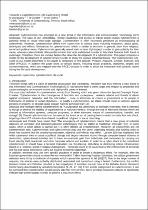JavaScript is disabled for your browser. Some features of this site may not work without it.
- ResearchSpace
- →
- Research Publications/Outputs
- →
- Conference Publications
- →
- View Item
| dc.contributor.author |
Veerasamy, Namosha

|
|
| dc.contributor.author |
Grobler, M

|
|
| dc.contributor.author |
Von Solms, S

|
|
| dc.date.accessioned | 2013-02-08T07:17:00Z | |
| dc.date.available | 2013-02-08T07:17:00Z | |
| dc.date.issued | 2012-08 | |
| dc.identifier.citation | Veerasamy, N, Grobler, M and Von Solms, S. 2012. Towards a Cyberterrorism Life-Cycle (CLC) Model. Proceedings of the 4th Workshop on ICT Uses in Warfare and the Safeguarding of Peace 2012 (IWSP 2012), Sandton, 16 August 2012, pp. 51-60 | en_US |
| dc.identifier.isbn | 978-1-86840-727-9 | |
| dc.identifier.uri | http://is.ukzn.ac.za/Libraries/information_Security_documents/Proceedings.sflb.ashx | |
| dc.identifier.uri | http://hdl.handle.net/10204/6540 | |
| dc.description | Proceedings of the 4th Workshop on ICT Uses in Warfare and the Safeguarding of Peace 2012 (IWSP 2012), Sandton, 16 August 2012 | en_US |
| dc.description.abstract | Cyberterrorism has emerged as a new threat in the Information and Communication Technology (ICT) landscape. The ease of use, affordability, remote capabilities and access to critical targets makes cyberterrorism a potential threat to cause wide-scale damage. Cyberterrorism is often incorrectly perceived as encompassing all cybercrimes. However, cyberterrorism differs from cybercrime in various ways including motivation, attack goals, techniques and effects. Motivations for cyberterrorism, which is similar to terrorism in general, stem from religious, social and political views. Cyberterrorists generally would seek to have high impact in order to gain publicity for their cause, whereas cybercriminals often prefer to have their acts undetected in order to hide their financial theft, fraud or espionage. Therefore, there are various factors that drive the development of a cyberterrorist. This paper proposes a model for the development of cyberterrorism in order to show the various influential forces. The Cyberterrorism Life-Cycle (CLC) model presented in this paper is composed of five phases: Prepare, Acquaint, Choose, Execute, and Deter (PACED). In addition the paper looks at various factors, including social, practices, objectives, targets and countermeasures, which are mapped onto the PACED phases in order to show the interaction and dynamic nature during the life-cycle development. | en_US |
| dc.language.iso | en | en_US |
| dc.publisher | CSIR also School of Management, IT, and Governance, University of KwaZulu-Natal | en_US |
| dc.relation.ispartofseries | Workflow;10282 | |
| dc.subject | Cybercrime | en_US |
| dc.subject | Cyberterrorism | en_US |
| dc.subject | Cyberterrorism Life-Cycle | en_US |
| dc.subject | CLC | en_US |
| dc.title | Towards a Cyberterrorism Life-Cycle (CLC) Model | en_US |
| dc.type | Conference Presentation | en_US |
| dc.identifier.apacitation | Veerasamy, N., Grobler, M., & Von Solms, S. (2012). Towards a Cyberterrorism Life-Cycle (CLC) Model. CSIR also School of Management, IT, and Governance, University of KwaZulu-Natal. http://hdl.handle.net/10204/6540 | en_ZA |
| dc.identifier.chicagocitation | Veerasamy, Namosha, M Grobler, and S Von Solms. "Towards a Cyberterrorism Life-Cycle (CLC) Model." (2012): http://hdl.handle.net/10204/6540 | en_ZA |
| dc.identifier.vancouvercitation | Veerasamy N, Grobler M, Von Solms S, Towards a Cyberterrorism Life-Cycle (CLC) Model; CSIR also School of Management, IT, and Governance, University of KwaZulu-Natal; 2012. http://hdl.handle.net/10204/6540 . | en_ZA |
| dc.identifier.ris | TY - Conference Presentation AU - Veerasamy, Namosha AU - Grobler, M AU - Von Solms, S AB - Cyberterrorism has emerged as a new threat in the Information and Communication Technology (ICT) landscape. The ease of use, affordability, remote capabilities and access to critical targets makes cyberterrorism a potential threat to cause wide-scale damage. Cyberterrorism is often incorrectly perceived as encompassing all cybercrimes. However, cyberterrorism differs from cybercrime in various ways including motivation, attack goals, techniques and effects. Motivations for cyberterrorism, which is similar to terrorism in general, stem from religious, social and political views. Cyberterrorists generally would seek to have high impact in order to gain publicity for their cause, whereas cybercriminals often prefer to have their acts undetected in order to hide their financial theft, fraud or espionage. Therefore, there are various factors that drive the development of a cyberterrorist. This paper proposes a model for the development of cyberterrorism in order to show the various influential forces. The Cyberterrorism Life-Cycle (CLC) model presented in this paper is composed of five phases: Prepare, Acquaint, Choose, Execute, and Deter (PACED). In addition the paper looks at various factors, including social, practices, objectives, targets and countermeasures, which are mapped onto the PACED phases in order to show the interaction and dynamic nature during the life-cycle development. DA - 2012-08 DB - ResearchSpace DP - CSIR KW - Cybercrime KW - Cyberterrorism KW - Cyberterrorism Life-Cycle KW - CLC LK - https://researchspace.csir.co.za PY - 2012 SM - 978-1-86840-727-9 T1 - Towards a Cyberterrorism Life-Cycle (CLC) Model TI - Towards a Cyberterrorism Life-Cycle (CLC) Model UR - http://hdl.handle.net/10204/6540 ER - | en_ZA |






